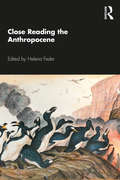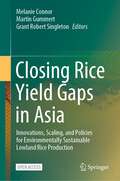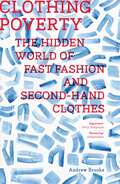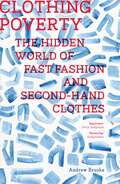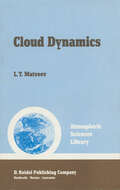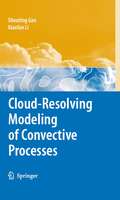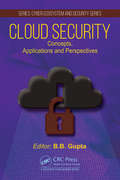- Table View
- List View
Clinical and Biomedical Engineering in the Human Nose: A Computational Fluid Dynamics Approach (Biological and Medical Physics, Biomedical Engineering)
by Kiao Inthavong Narinder Singh Eugene Wong Jiyuan TuThis book explores computational fluid dynamics in the context of the human nose, allowing readers to gain a better understanding of its anatomy and physiology and integrates recent advances in clinical rhinology, otolaryngology and respiratory physiology research. It focuses on advanced research topics, such as virtual surgery, AI-assisted clinical applications and therapy, as well as the latest computational modeling techniques, controversies, challenges and future directions in simulation using CFD software. Presenting perspectives and insights from computational experts and clinical specialists (ENT) combined with technical details of the computational modeling techniques from engineers, this unique reference book will give direction to and inspire future research in this emerging field.
Close Binaries in the 21st Century: New Opportunities and Challenges
by Alvaro Gimenez Edward Guinan Panagiotis Niarchos Slavek RucinskiThis book is the proceedings of an international conference entitled "Close Binaries in the 21st Century: New Opportunities and Challenges", held in Syros island, Greece, June 27-30, 2005. The papers collected in this volume detail the latest achievements in the field and reflect the state of the art of the dynamically evolving area of binary star research.
Close Calls: Managing Risk and Resilience in Airline Flight Safety
by C. MacraeDrawing on extensive and detailed fieldwork within airlines-an industry that pioneered near-miss analysis- this book develops a clear set of practical implications and theoretical propositions regarding how all organizations can learn from 'near-miss' events and better manage risk and resilience.
Close Encounters of Art and Physics: An Artist's View
by Laura PesceClose Encounters of Art and Physics is a voyage in time through the abstract ideas harboured in the minds of humans, starting from the graffiti art of cave dwellers and extending to the street art of contemporary men and women. In seeking parallels with science, the author looks far back to the first geometric ideas of our ancestors as well as ahead to the contemporary science of present-day physicists. The parallelism and analogies between these two fields bear witness to a real entanglement in the human brain. The second part of the book contains about 25 colour images showing the author's stunning glass artwork representing ideas such as dark matter, quantum entanglement, cellular automata and many others that are almost impossible to capture in words. Furthermore, many of the physicists who have themselves made major contributions in these fields provide their comments and analysis of the works. The book provides entertaining and informative reading, not only for practicing artists and physicists, but also anyone curious about art and physics.
Close Reading the Anthropocene
by Helena FederReading poetry and prose, images and art, literary and critical theory, science and cultural studies, Close Reading the Anthropocene explores the question of meaning, its importance and immanent potential for loss, in the new geological epoch of the Anthropocene. Both close reading and scientific ecology prioritize slowing down and looking around to apprehend similarities and differences, to recognize and value interconnections. Here "close" suggests careful attention to both the reading subject and read "object." Moving between places, rocks, plants, animals, atmosphere, and eclipses, this interdisciplinary edited collection grounds the complex relations between text and world in the environmental humanities. The volume’s wide-ranging chapters are critical, often polemical, engagements with the question of the Anthropocene and the changing conversation around reading, interpretation, and textuality. They exemplify a range of work from across the globe and will be of great interest to scholars and students of the environmental humanities, ecocriticism, and literary studies.
Close Reading the Anthropocene
by Helena FederReading poetry and prose, images and art, literary and critical theory, science and cultural studies, Close Reading the Anthropocene explores the question of meaning, its importance and immanent potential for loss, in the new geological epoch of the Anthropocene. Both close reading and scientific ecology prioritize slowing down and looking around to apprehend similarities and differences, to recognize and value interconnections. Here "close" suggests careful attention to both the reading subject and read "object." Moving between places, rocks, plants, animals, atmosphere, and eclipses, this interdisciplinary edited collection grounds the complex relations between text and world in the environmental humanities. The volume’s wide-ranging chapters are critical, often polemical, engagements with the question of the Anthropocene and the changing conversation around reading, interpretation, and textuality. They exemplify a range of work from across the globe and will be of great interest to scholars and students of the environmental humanities, ecocriticism, and literary studies.
Closed Loop Management in Mineral Resource Extraction: Turning Online Geo-Data into Mining Intelligence (SpringerBriefs in Applied Sciences and Technology)
by Jörg BenndorfThis book describes an innovative closed-loop concept that allows the feedback of online data from operational monitoring to create mining intelligence. The application of this concept promises significant improvements in economic and environmental key performance indicators for any mining operation.Combining theory with industrial case studies, the book guides readers through this process by providing theoretical background, addressing practical issues related to operational implementation, and illustrating the impact on selected examples. This new concept is presented using the example of a bulk and gold mining application, but is applicable at any mine where grade control is important.The book is of interest to industrial professionals involved in operational monitoring, mining intelligence, and mine planning optimization, as well as to researchers and academics in the field of applied geostatistics.
Closet Space: Geographies of Metaphor from the Body to the Globe (Critical Geographies Ser.)
by Michael P. BrownIs the closet just a metaphor? Closet Space provides a highly original account of the spatial metaphor of "the closet", and is the first geography text to focus on this important issue. Using a variety of research techniques and materials, the book explores the closet through texts including:* the oral histories of gay men in the UK and US* the sexualised landscape of a New Zealand city* the national census of Britain and the US* international travel guides and traveloguesand refers to the work of Butler, Lefebvre and Foucault.
Closet Space: Geographies of Metaphor from the Body to the Globe
by Michael P. BrownIs the closet just a metaphor? Closet Space provides a highly original account of the spatial metaphor of "the closet", and is the first geography text to focus on this important issue. Using a variety of research techniques and materials, the book explores the closet through texts including:* the oral histories of gay men in the UK and US* the sexualised landscape of a New Zealand city* the national census of Britain and the US* international travel guides and traveloguesand refers to the work of Butler, Lefebvre and Foucault.
Closing Rice Yield Gaps in Asia: Innovations, Scaling, and Policies for Environmentally Sustainable Lowland Rice Production
by Melanie Connor Martin Gummert Grant Robert SingletonThis open access book contributes not only to the scientific literature on sustainable agricultural development and in particular rice agriculture but also is highly valuable to assist practitioners, projects, and policymakers due to its sections on reducing carbon footprint, agricultural innovations, and lessons learned from a multi-country/multi-stages development project. The scope of the book is conceived as a detailed documentation of the implementation, dissemination, and impact of the CORIGAP project in Sri Lanka, Myanmar, Thailand, China, Vietnam, and Indonesia, with spill-over to Cambodia and the Philippines. It pulls together actionable research findings with the experience of bringing these findings into use. The aim of the book is to provide a wide array of pathways to impact for sustainable rice production in lowland irrigated rice-based agricultural systems. The book is written by local actors of the rice value chain, researchers, and engineers working on a range of best management practices, climate-smart rice production innovations, knowledge translation, and dissemination, as well as decision-making and policy aspects. It is envisioned that the contents of the book can be translated into messages that can help farmers, extension workers, policymakers, and funders of agricultural development, decide on implementing best management practices and climate-smart technologies in their agroecological systems by presenting the technological/practical options along the rice value chain and the partnerships and business models required for their implementation. The book is aimed at practitioners, extension specialists, researchers, and engineers interested in information on current best management practices, sustainable, and climate-smart rice production and constraints that need further investigation. Furthermore, the book is also aimed at policymakers and agricultural development funders required by public opinion and legally binding agreements to reduce greenhouse gas emissions, conserve biodiversity and increase agroecological practices, who are looking for research-based evidence to guide policymaking and implementation.
Closing the Knowledge-Implementation Gap in Conservation Science: Interdisciplinary Evidence Transfer Across Sectors and Spatiotemporal Scales (Wildlife Research Monographs #4)
by Catarina C. Ferreira Cornelya F. C. KlütschThis book aims to synthesize the state of the art on biodiversity knowledge exchange practices to understand where and how improvements can be made to close the knowledge-implementation gap in conservation science and advance this interdisciplinary topic. Bringing together the most prominent scholars and practitioners in the field, the book looks into the various sources used to produce biodiversity knowledge - from natural and social sciences to Traditional Ecological Knowledge and Citizen Science - as well as knowledge mobilization approaches to highlight the key ingredients that render successful conservation action at a global scale. By doing so, the book identified major current challenges and opportunities in the field, for different sectors that generate, mobilize, and use biodiversity knowledge (like academia, boundary organizations, practitioners, and policy-makers), to further develop cross-sectorial knowledge mobilization strategies and enhance evidence-informed decision-making processes globally.
Clothing Poverty: The Hidden World of Fast Fashion and Second-Hand Clothes
by Andrew Brooks'An interesting and important account.'Daily TelegraphHave you ever stopped and wondered where your jeans came from? Who made them and where? Ever wondered where they end up after you donate them for recycling?Following a pair of jeans, Clothing Poverty takes the reader on a vivid around-the-world tour to reveal how clothes are manufactured and retailed, bringing to light how fast fashion and clothing recycling are interconnected. Andrew Brooks shows how recycled clothes are traded across continents, uncovers how retailers and international charities are embroiled in commodity chains which perpetuate poverty, and exposes the hidden trade networks which transect the globe.Stitching together rich narratives, from Mozambican markets, Nigerian smugglers and Chinese factories to London's vintage clothing scene, TOMS shoes and Vivienne Westwood's ethical fashion lines, Brooks uncovers the many hidden sides of fashion.
Clothing Poverty: The Hidden World of Fast Fashion and Second-Hand Clothes
by Andrew BrooksHave you ever stopped and wondered where your jeans came from? Who made them and where? Ever wondered where they end up after you donate them for recycling?Following a pair of jeans, Clothing Poverty takes the reader on a vivid around-the-world tour to reveal how clothes are manufactured and retailed, bringing to light how fast fashion and recycling are interconnected. Andrew Brooks shows how recycled clothes are traded across continents, uncovers how retailers and international charities are embroiled in commodity chains which perpetuate poverty, and exposes the hidden trade networks which transect the globe.In this new and updated edition, Brooks retraces his steps to look at the fashion industry today, and considers how, if at all, the industry has changed in response to mounting consumer pressure for more ethical clothing. Stitching together rich narratives, from Mozambican markets, Nigerian smugglers and Chinese factories to London's vintage clothing scene, TOMS shoes and Vivienne Westwood's ethical fashion lines, Brooks uncovers the many hidden sides of fashion.
Clothing Poverty: The Hidden World of Fast Fashion and Second-Hand Clothes
by Andrew Brooks'An interesting and important account.'Daily TelegraphHave you ever stopped and wondered where your jeans came from? Who made them and where? Ever wondered where they end up after you donate them for recycling?Following a pair of jeans, Clothing Poverty takes the reader on a vivid around-the-world tour to reveal how clothes are manufactured and retailed, bringing to light how fast fashion and clothing recycling are interconnected. Andrew Brooks shows how recycled clothes are traded across continents, uncovers how retailers and international charities are embroiled in commodity chains which perpetuate poverty, and exposes the hidden trade networks which transect the globe.Stitching together rich narratives, from Mozambican markets, Nigerian smugglers and Chinese factories to London's vintage clothing scene, TOMS shoes and Vivienne Westwood's ethical fashion lines, Brooks uncovers the many hidden sides of fashion.
Clothing Poverty: The Hidden World of Fast Fashion and Second-Hand Clothes
by Andrew BrooksHave you ever stopped and wondered where your jeans came from? Who made them and where? Ever wondered where they end up after you donate them for recycling?Following a pair of jeans, Clothing Poverty takes the reader on a vivid around-the-world tour to reveal how clothes are manufactured and retailed, bringing to light how fast fashion and recycling are interconnected. Andrew Brooks shows how recycled clothes are traded across continents, uncovers how retailers and international charities are embroiled in commodity chains which perpetuate poverty, and exposes the hidden trade networks which transect the globe.In this new and updated edition, Brooks retraces his steps to look at the fashion industry today, and considers how, if at all, the industry has changed in response to mounting consumer pressure for more ethical clothing. Stitching together rich narratives, from Mozambican markets, Nigerian smugglers and Chinese factories to London's vintage clothing scene, TOMS shoes and Vivienne Westwood's ethical fashion lines, Brooks uncovers the many hidden sides of fashion.
Cloud and Weather Modification: A Group of Field Experiments (Meteorological Monographs #2)
by Sverre PetterssenThe objects of the American Meteorological Society are "the development and dissemination of knowledge of meteorology in all its phases and applications, and the advancement of its professional ideals." The organization of the Society took place in affiliation with the American Association for the Advancement of Science at Saint Louis, Missouri, December 29, 1919, and its incorporation, at Washington, D. C., January 21, 1920. The work of the Society is carried on by the Bulletin, the Journal, and Meteorological Monographs, by papers and discussions at meetings of the Society, through the offices of the Secretary and the Executive Secretary, and by correspondence. All of the Americas are represented in the membership of the Society as well as many foreign countries.
The Cloud Collector's Handbook
by Gavin Pretor-PinneyTHE CLOUD COLLECTOR'S HANDBOOK fits into the pocket, allowing cloudspotters to identify cloud formations anytime and anywhere. All the common cloud types are represented, as are many of the rare ones, each fully described and illustrated with a range of photographs. Not only is THE CLOUD COLLECTOR'S HANDBOOK an invaluable resource for anyone who wants to be able to identify and understand every cloud that floats by, it also caters for the competitive cloudspotter. Points are awarded for each cloud type identified - the rarer the cloud, the greater points - and there's space to fill in where and when it was sighted.Beautifully designed, in colour throughout, and full of the humour that made THE CLOUDSPOTTER'S GUIDE so engaging, the HANDBOOK is the essential reference for anyone with their head in the clouds.
Cloud Computing for Geospatial Big Data Analytics: Intelligent Edge, Fog And Mist Computing (Studies in Big Data #49)
by Himansu Das Rabindra K. Barik Harishchandra Dubey Diptendu Sinha RoyThis book introduces the latest research findings in cloud, edge, fog, and mist computing and their applications in various fields using geospatial data. It solves a number of problems of cloud computing and big data, such as scheduling, security issues using different techniques, which researchers from industry and academia have been attempting to solve in virtual environments. Some of these problems are of an intractable nature and so efficient technologies like fog, edge and mist computing play an important role in addressing these issues. By exploring emerging advances in cloud computing and big data analytics and their engineering applications, the book enables researchers to understand the mechanisms needed to implement cloud, edge, fog, and mist computing in their own endeavours, and motivates them to examine their own research findings and developments.
Cloud Dynamics (Atmospheric and Oceanographic Sciences Library #2)
by L.T. MatveevDuring recent decades a new field of study in atmospheric science has made its appearance - the dynamics of clouds. As the name implies, the subject matter of cloud dynamics includes the causes of cloud formation and the temporal development of clouds. At first, effort was concentrated mainly on devising models of the structure and development of convective clouds, and thus there exists considerable literature on this [9, 69, 88, 330, 411]. Although convective clouds are of great significance (thunder storm formation and very intense turbulence are associated with these clouds), they are observed much less frequently than other cloud types. For instance, the frequency of occurrence of strati form (frontal) clouds and wave clouds over the U.S.S.R. and Western Europe is more than 90% [2-4]. During the last 20 or 30 years there has been considerable success in studying the dynamics of stratiform clouds. Fundamental laws (equations) describing the formation, development, and dis sipation of these clouds (and also of fog) have been formulated, and also laws describing the formation of humidity and temperature fields in a turbulent medium. Hydrodynamic models of clouds and fog constructed on the basis of these equations have made it pos sible to formulate the fundamental regularities in the formation and evolution of large-scale cloud fields, and also to ascertain the structural features of clouds of various kinds. These topics are covered in Chapters 1-4 of this monograph.
Cloud Multi-phase Processes and High Alpine Air and Snow Chemistry: Ground-based Cloud Experiments and Pollutant Deposition in the High Alps (Transport and Chemical Transformation of Pollutants in the Troposphere #5)
by Sandro Fuzzi and Dietmar WagenbachAmong the chemical and physical processes involved in the transformation of pollutants between their sources and their ultimate deposition, those associated with clouds, aerosols and precipitation must be rated as the most difficult both to study and to understand. This book presents a variety of recent advances in this field, including the properties and composition of aerosol particles, chemical transformation and scavenging processes, the relationship between liquid-phase chemistry and cloud micro-physics, entrainment, evaporation and deposition, trends in high Alpine pollution, transport processes, and developments in instrumentation. This book is Volume 5 in the ten-volume series on Transport and Chemical Transformation of Pollutants in the Troposphere.
Cloud Optics (Atmospheric and Oceanographic Sciences Library #34)
by Alexander A. KokhanovskyClouds affect the climate of the Earth, and they are an important factor in the weather. Therefore, their radiative properties must be understood in great detail. This book summarizes current knowledge on cloud optical properties, for example their ability to absorb, transmit, and reflect light, which depends on the clouds’ geometrical and microphysical characteristics such as sizes of droplets and crystals, their shapes, and structures. In addition, problems related to the image transfer through clouds and cloud remote sensing are addressed in this book in great detail. This book can be an important source of information on theoretical cloud optics for cloud physicists, meteorologists and optical engineers. All basic ideas of optics as related to scattering of light in clouds (e.g. Mie theory and radiative transfer) are considered in a self consistent way. Consequently, the book can also be a useful textbook to newcomers to the field.
Cloud-Resolving Modeling of Convective Processes
by Shouting Gao Xiaofan LiClouds and cloud systems and their interactions with larger scales of motion, radiation, and the Earth’s surface are extremely important parts of weather and climate systems. Their treatment in weather forecast and climate models is a significant source of errors and uncertainty. As computer power increases, it is beginning to be possible to explicitly resolve cloud and precipitation processes in these models, presenting opportunities for improving precipitation forecasts and larger-scale phenomena such as tropical cyclones which depend critically on cloud and precipitation physics. This book by Professor Shouting Gao of the Institute of Atmospheric Physics in Beijing and Xiaofan Li of NOAA’s National Environmental Satellite Data and Information Services (NESDIS) presents an update and review of results of high-resolution, mostly two-dimensional models of clouds and precipitation and their interactions with larger scales of motion and the Earth’s surface. It provides a thorough description of cloud and precipitation physics, including basic governing equations and related physics, such as phase changes of water, radiation and mixing. Model results are compared with observations from the 1992-93 Tropical Ocean Global Atmosphere Coupled Ocean Atmosphere Response Experiment (TOGA COARE) experiment. The importance of the ocean to tropical convective systems is clearly shown here in the numerical results of simulations with their air-sea coupled modeling system. While the focus is on tropical convection, the methodology and applicability can be extended to cloud and precipitation processes elsewhere. The results described in this well-written book form a solid foundation for future high-resolution model weather forecasts and climate simulations that resolve clouds explicitly in three dimensions—a future that has great promise for the understanding and prediction of weather and climate for the great benefit of society.
Cloud-Resolving Modeling of Convective Processes (Springer Atmospheric Sciences)
by Xiaofan Li Shouting GaoThis is an updated and revised second edition of the book presenting new developments in the field of cloud-resolving modeling. The first edition of the book introduces the framework of cloud-resolving model, methodologies for analysis of modeling outputs, and validation of simulations with observations. It details important scientific findings in the aspects of surface rainfall processes, precipitation efficiency, dynamic and thermodynamic processes associated with tropical convection, diurnal variations, radiative and cloud microphysical processes associated with development of cloud clusters, air-sea coupling on convective scales, climate equilibrium states, and remote sensing applications. In additional to the content from the first edition of the book, the second edition of the book contains the new scientific results in the development of convective-stratiform rainfall separation scheme, the analysis of structures of precipitation systems, the thermal effects of doubled carbon dioxide on rainfall, precipitation predictability, and modeling depositional growth of ice crystal. The book will be beneficial both to graduate students and to researchers who do cloud, mesoscale and global modeling.
Cloud Security: Concepts, Applications and Perspectives (Cyber Ecosystem and Security)
by Brij B. GuptaCloud computing is an indispensable part of the modern Information and Communication Technology (ICT) systems. Cloud computing services have proven to be of significant importance, and promote quickly deployable and scalable IT solutions with reduced infrastructure costs. However, utilization of cloud also raises concerns such as security, privacy, latency, and governance, that keep it from turning into the predominant option for critical frameworks. As such, there is an urgent need to identify these concerns and to address them.Cloud Security: Concepts, Applications and Perspectives is a comprehensive work with substantial technical details for introducing the state-of-the-art research and development on various approaches for security and privacy of cloud services; novel attacks on cloud services; cloud forensics; novel defenses for cloud service attacks; and cloud security analysis. It discusses the present techniques and methodologies, and provides a wide range of examples and illustrations to effectively show the concepts, applications, and perspectives of security in cloud computing. This highly informative book will prepare readers to exercise better protection by understanding the motivation of attackers and to deal with them to mitigate the situation. In addition, it covers future research directions in the domain. This book is suitable for professionals in the field, researchers, students who are want to carry out research in the field of computer and cloud security, faculty members across universities, and software developers engaged in software development in the field.
Cloud Security: Concepts, Applications and Perspectives (Cyber Ecosystem and Security)
by Brij B GuptaCloud computing is an indispensable part of the modern Information and Communication Technology (ICT) systems. Cloud computing services have proven to be of significant importance, and promote quickly deployable and scalable IT solutions with reduced infrastructure costs. However, utilization of cloud also raises concerns such as security, privacy, latency, and governance, that keep it from turning into the predominant option for critical frameworks. As such, there is an urgent need to identify these concerns and to address them.Cloud Security: Concepts, Applications and Perspectives is a comprehensive work with substantial technical details for introducing the state-of-the-art research and development on various approaches for security and privacy of cloud services; novel attacks on cloud services; cloud forensics; novel defenses for cloud service attacks; and cloud security analysis. It discusses the present techniques and methodologies, and provides a wide range of examples and illustrations to effectively show the concepts, applications, and perspectives of security in cloud computing. This highly informative book will prepare readers to exercise better protection by understanding the motivation of attackers and to deal with them to mitigate the situation. In addition, it covers future research directions in the domain. This book is suitable for professionals in the field, researchers, students who are want to carry out research in the field of computer and cloud security, faculty members across universities, and software developers engaged in software development in the field.




